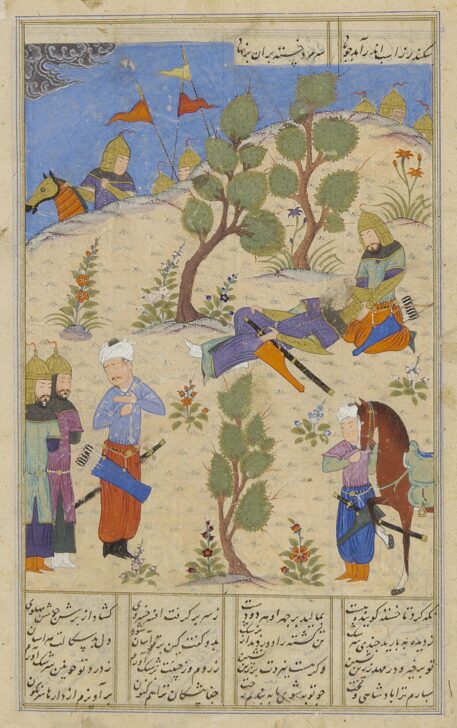The Death of Dara, from the Shahnama of Firdausi
Iranian

Description
One of the most famous episodes in the life of Alexander the Great—known in Persian as Sikandar or Iskandar—occurred in 330 B.C.E., during his long march in pursuit of Darius, the last monarch of the Achmenid Persian empire. Darius (Dara, in Persian) had fled into northern Afghanistan, but he was betrayed and murdered by his own men, who abandoned his body in the desert. When Alexander came upon the body he cradled Darius’ head in his lap, and cried at the loss of so worthy an opponent. The great Persian king opened his eyes and spoke once more, naming Alexander as his successor. It is a stirring tale that most modern historians reject as myth-making from the pen of Alexander’s historians, but perfectly in keeping with the valorization of personal honor in battle that characterizes the Shahnama.
The ministers came to Sikandar, saying:
“O Shah victorious and endowed with knowledge!
We have surprised and slain thine enemy;
The crown and throne of chiefs are his no more.”
The Ruman’s heart and soul
Were filled with rage and grief. On drawing nigh
He gazed upon Dara and saw his breast
All blood, his countenance like fenugreek,
Gave orders to alight and set a guard
O’er those two ministers, and then, dismounting
As swift as wind himself, took on his lap
The wounded monarch’s head. …
Warner, VI, 52–53
Alexander's conquest of Persia brought an end to the Achemenid Dynasty and initiated a century and a half of Greek rule. Although Alexander was long reviled in the region, later historians invented a tale that he was descended from the Persian royal line through his mother, thus removing the stigma of his being an outsider. He plays a major role in the Shahnama as the first shah of the "Historical Age."
———
Maribeth Graybill, Senior Curator of Asian Art
Exhibited in "A Medieval Masterpiece from Baghdad: the Ann Arbor Shahnama"
August 14 through December 19, 2004
Subject Matter:
The Death of Dara
The ministers came to Sikandar, saying:--
'O Shah victorious and endowed with knowledge!
We have surprised and slain thine enemy;
The crown and throne of chiefs are his no more."
The Ruman's heart and soul
Were filled with rage and gried. On drawing nigh
He gazed upon Dara and saw his breast
All blood, his countenance like fenugreek,
Gave orders to alight and set a guard
O'er those two ministers, and then, dismounting
As swift as wind himself, took on his lap
The wounded monarch's head...
Physical Description:
This Persian miniature is attributed to the Shiraz and Timurid schools, ca. 1460. The painting is done in ink, opaque watercolor and gold leaf on paper. The scene, The Death of Dara, is part of the Shahnama of Firdausi, the Persian book of kings.
Usage Rights:
If you are interested in using an image for a publication, please visit https://umma.umich.edu/request-image/ for more information and to fill out the online Image Rights and Reproductions Request Form.